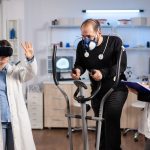VR-based training is defined by using computer hardware and software generated user-computer interface for users to interact with virtual environments that relate to the real world to facilitate task- oriented training and provide multimodal feedback to augment functional recovery. VR is defined as a “computer-based technology that allows users to interact with a multisensory simulated environment and receive ‘real- time’ feedback on performance
-
-
Phone+91 94431 71443
-
Office Hours Monday - Saturday




